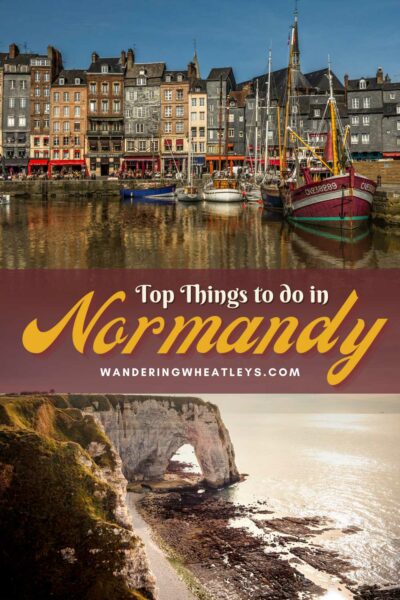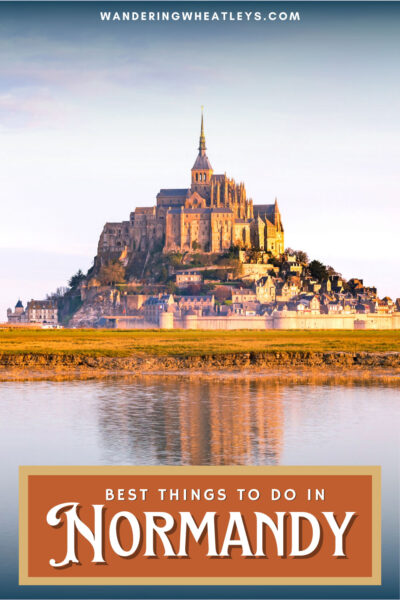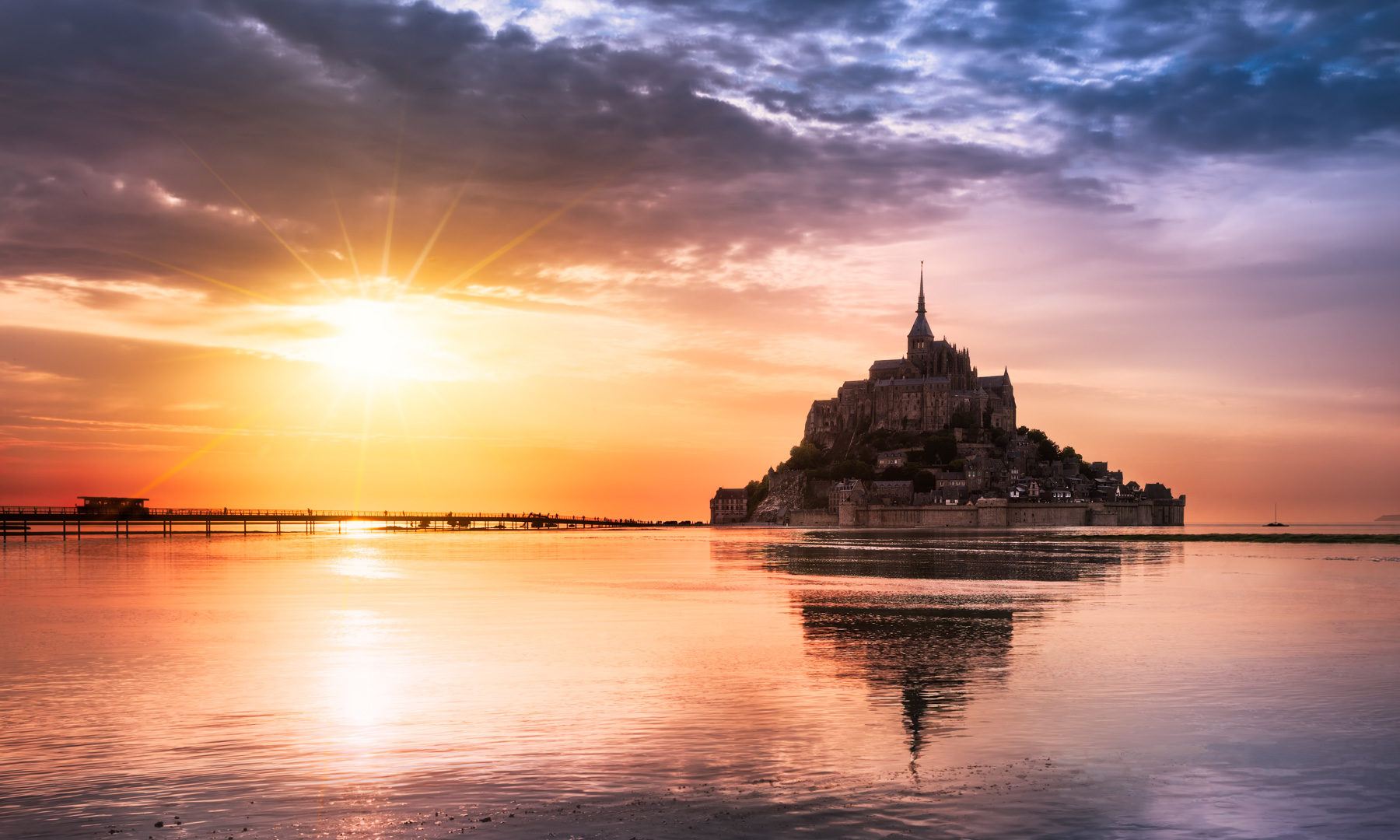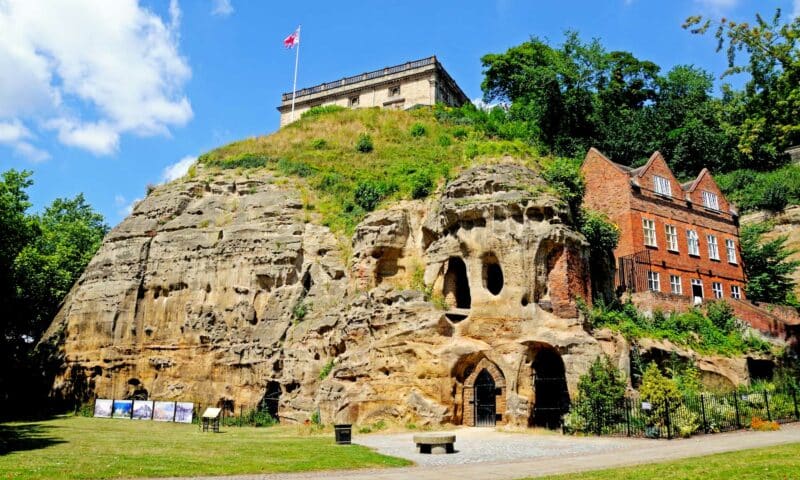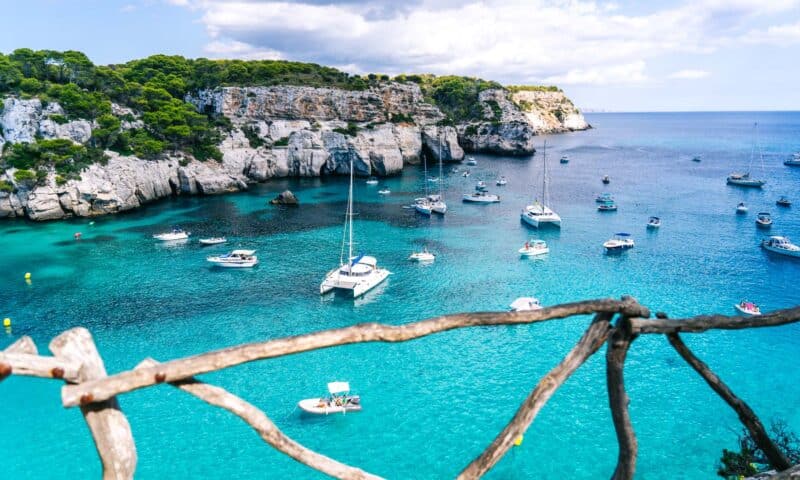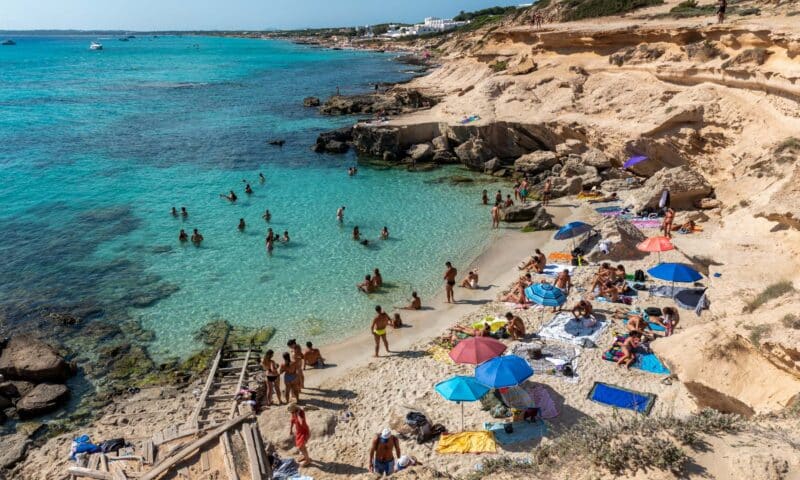Normandy is one of France’s most fascinating destinations, and we know you’re going to love exploring colorful seaside towns overlooking the English Channel, ancient cities packed with Norman history, and beautiful villages that have inspired generations of artists and painters.
We love Normandy for its rural idylls, its excellent Calvados brandy, and for its breathtaking sights like Mont-Saint-Michel and Rouen Cathedral. Normandy is the land of William the Conqueror, and there are medieval abbeys in every town square and castles on every hilltop!
And, of course, Normandy is well known for its role in World War II, the events of which still scar the landscape today. For a poignant look at this 20th-century history, then head to Utah or Omaha beach before visiting the excellent Memorial de Caen to learn more.
With so many things to see and do, you might not know where to begin. That’s why we decided to compile our list of the best things to do in Normandy for you. Stick to these fun and unique Normandy bucket list recommendations, and there’s no doubt you’re going to have an incredible time exploring this gorgeous French region!
Don’t forget to check out our web story: The 15 Best Things to Do in Normandy
Disclaimer: This post may contain affiliate links. If you make a purchase or booking through one of our links we may earn a small commission (don’t worry, it’s at no extra cost to you).
15 Fun and Unique Things to do in Normandy
1. Cross the causeway to visit Mont-Saint-Michel
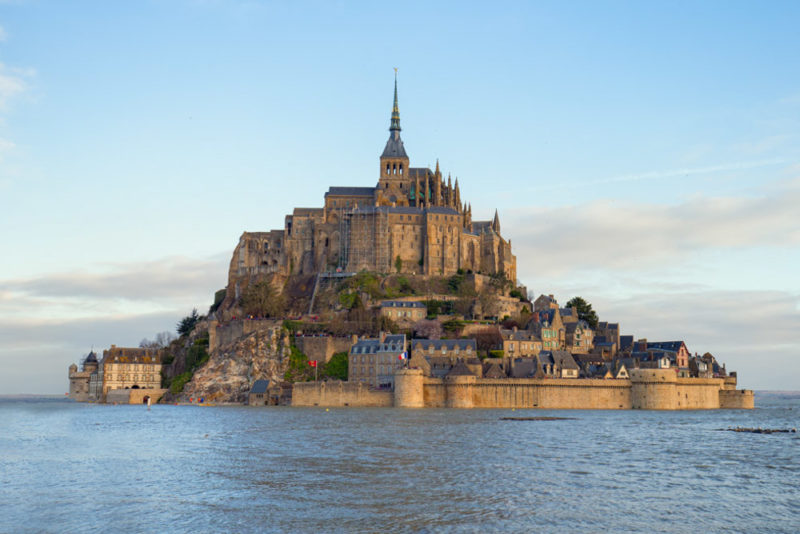
Mont-Saint-Michel is one of the most famous Normandy sightseeing attractions, and you won’t want to miss out on crossing the infamous causeway leading to this incredible tidal island.
Mont-Saint-Michel is located just off the coast of Normandy, and this extraordinary island is home to an abbey, fortress, and small but historic town that sits in the bay.
Mont-Saint-Michel has always been famed for its isolation, and the only way to reach the island is by crossing the raised, cobblestone causeway leading across the tidal mud flats. Be careful, though, because when the tide is too high, the causeway is completely inundated by water.
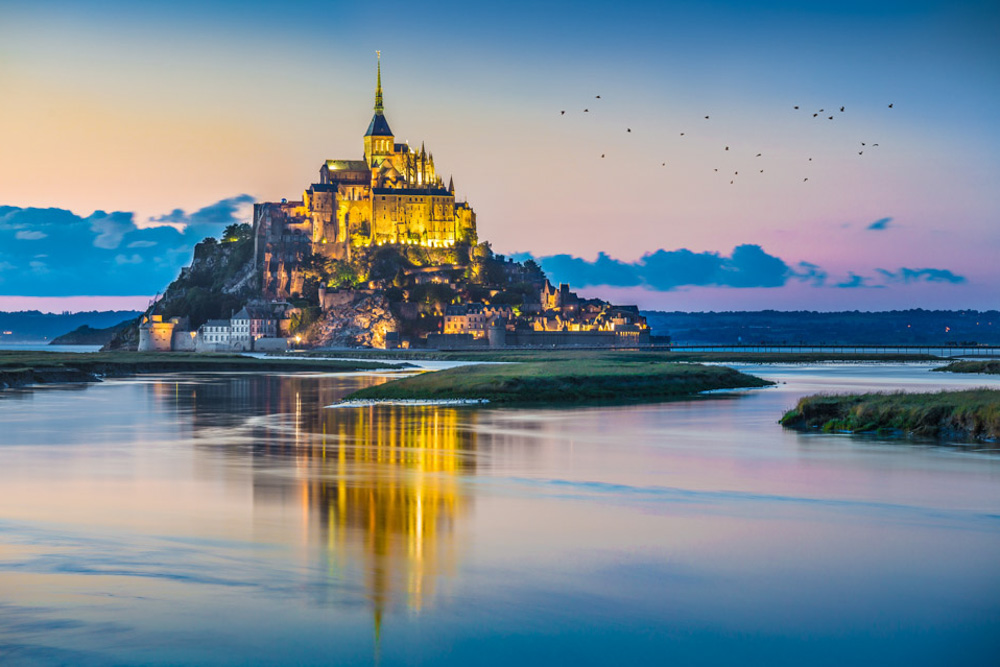
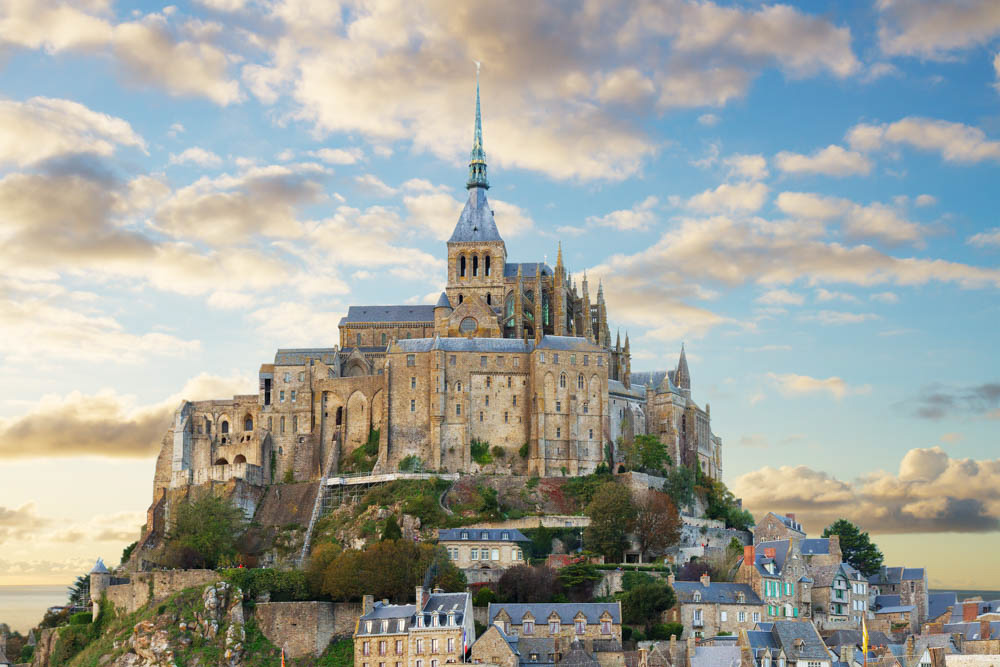
Mont-Saint-Michel’s history dates back to the 6th century AD, when Armoricans used the island as a fortress, although the Franks ultimately managed to take it some centuries later. The abbey that now rises so dramatically above the island was built from the 11th century onwards, while below the abbey are townhouses, towers, and walls that are so much fun to explore on foot.
Few other sights match Mont-Saint-Michel for its beauty, and we recommend saving time to watch the sunset (or sunrise) over the island from the mainland. You’ll love the view as you watch nature do its thing in one of France’s most spectacular sightseeing spots!
2. Visit the Bayeux Tapestry and see how England was conquered
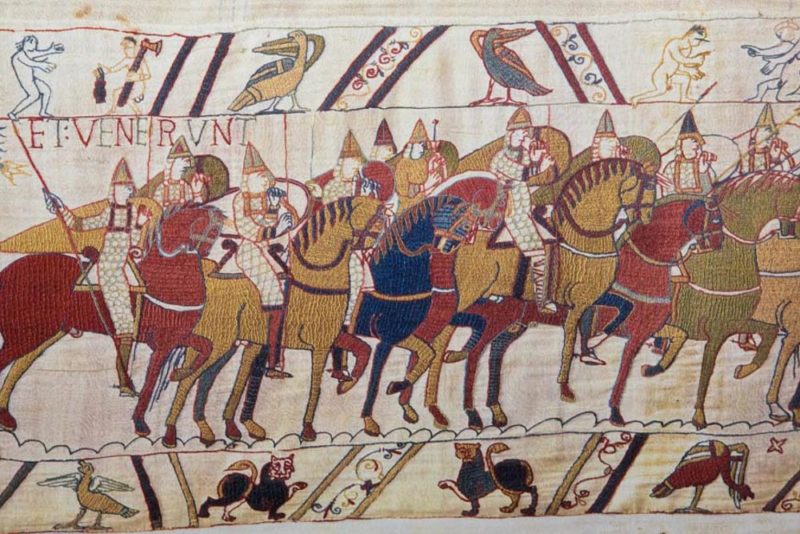
In 1066, William of Normandy set out across the English Channel and landed on the south coast of England. Shortly after, a fierce battle was fought at Hastings, where the Normans defeated King Harold and his Anglo-Saxon defenders. Soon enough, William’s army had taken London, and he was crowned King of England.
William the Conqueror, as he came to be known, was also Duke of Normandy, and to celebrate his victory over the English, he had an elaborate tapestry commissioned. The tapestry depicted William’s campaign to defeat the English and later found a permanent home in Bayeux Cathedral in Normandy.
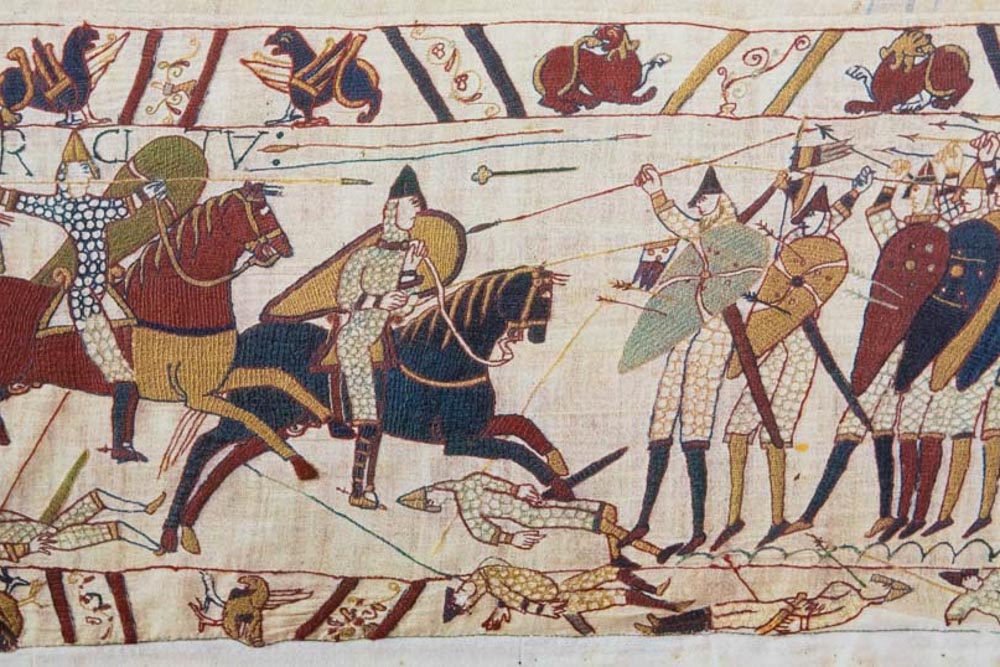
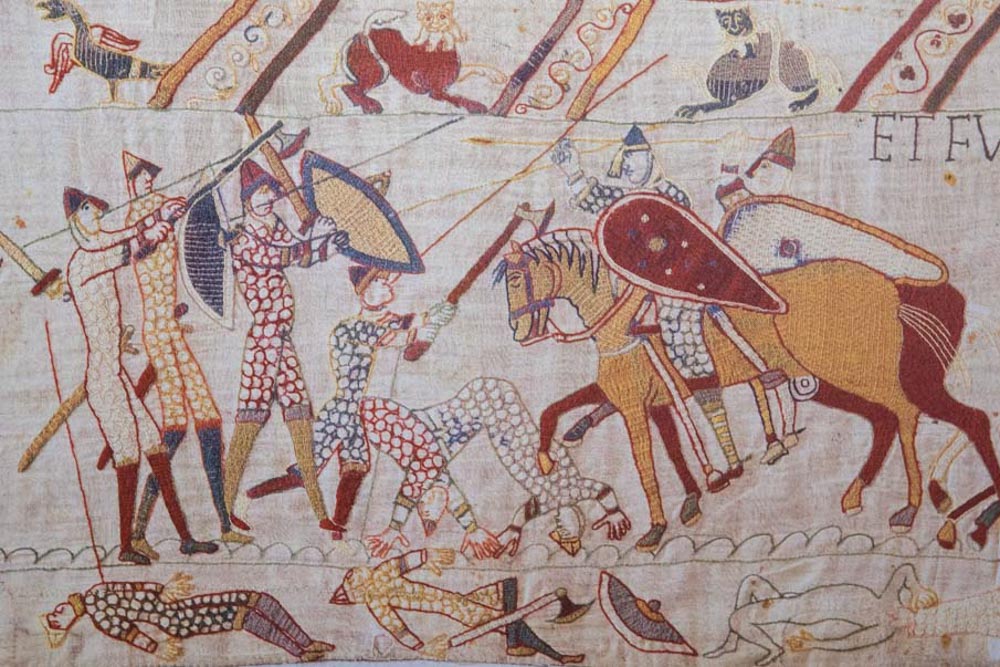
The Bayeux Tapestry is remarkable. It was embroidered and woven by hand and features 53 separate scenes that contain minuscule details of the medieval era. It’s a rich historical source, and you can see it in all its glory when you visit Bayeux Museum in Bayeux, where the tapestry is now held.
3. Visit the birthplace of William the Conqueror
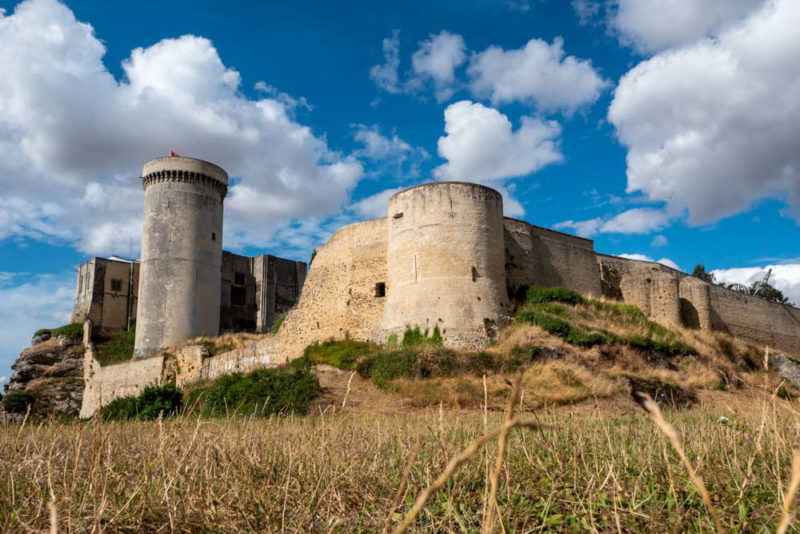
Normandy’s history is irrevocably tied to that of William the Conqueror, so why not visit the Duke and King’s birthplace when you’re in the region?
William the Conqueror was born around the year 1028 AD in Falaise, where the Dukes of Normandy had made their seat some years before. Norman history actually begins with the Vikings (the name Norman is derived from the word Northman), and William was descended from the powerful Norse raiders who had conquered the area in the 8th century AD.
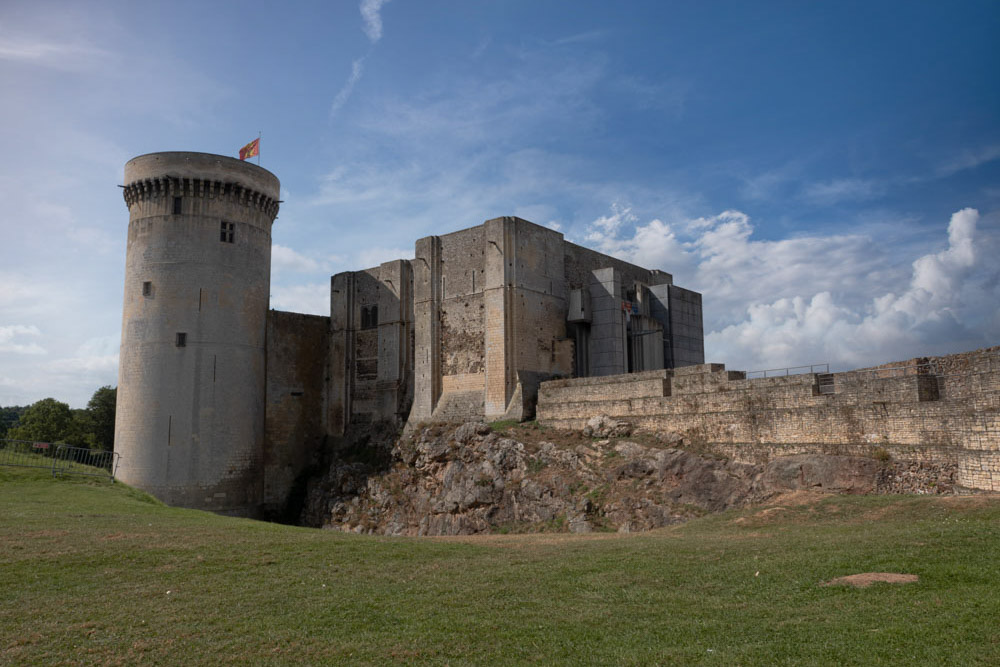
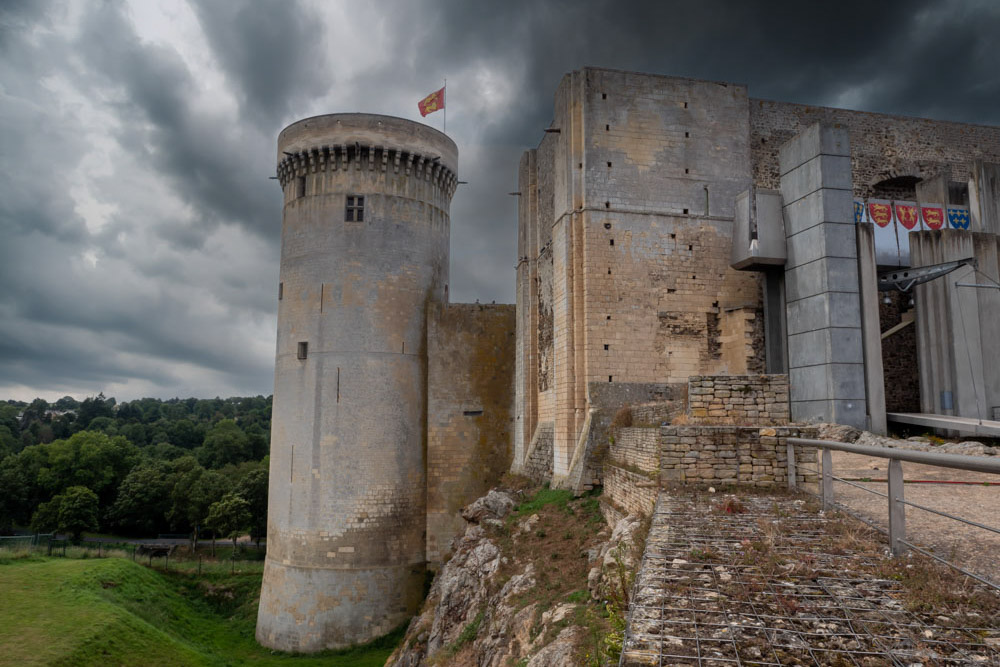
The Normans were a war-like people, and you’ll see this immediately when you visit the ruins of Falaise Castle. Unlike the quaint chateaux and manor houses that masqueraded as “castles” in later centuries, the Normans built towering defensive structures in strategic locations.
Falaise Castle consists of a tall stone tower and a large stone keep. Neither are aesthetic, but both are authentic pieces of medieval history that we highly recommend seeing!
4. Marvel at Rouen’s glorious cathedral
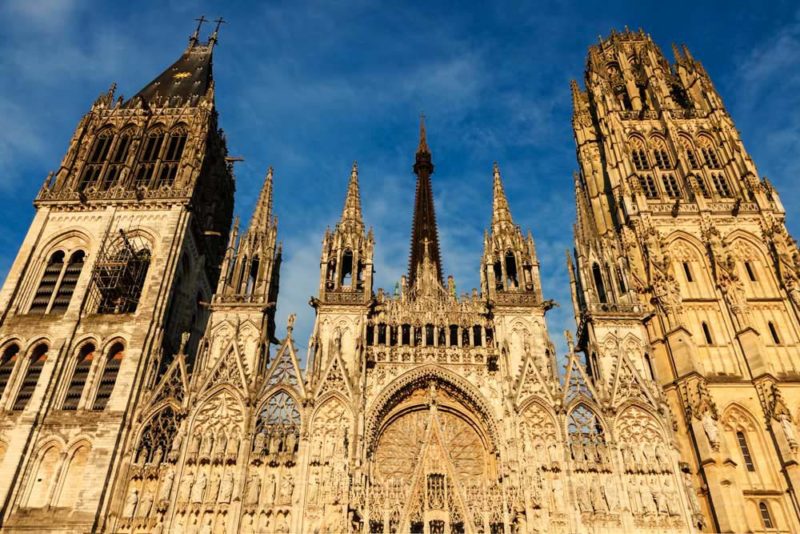
Rouen is the ancient capital of Normandy, so it should come as no surprise that the city is home to one of the most impressive cathedrals in France. Rouen Cathedral is a magnificent work of architecture, and you’ll love exploring its unique history when you’re in the city.
The first thing you’ll notice from a distance is that the three spires that rise above Rouen’s rooftops are all different. It’s unusual for a cathedral to have three spires, and each of them represents a different architectural style commissioned in a different era.
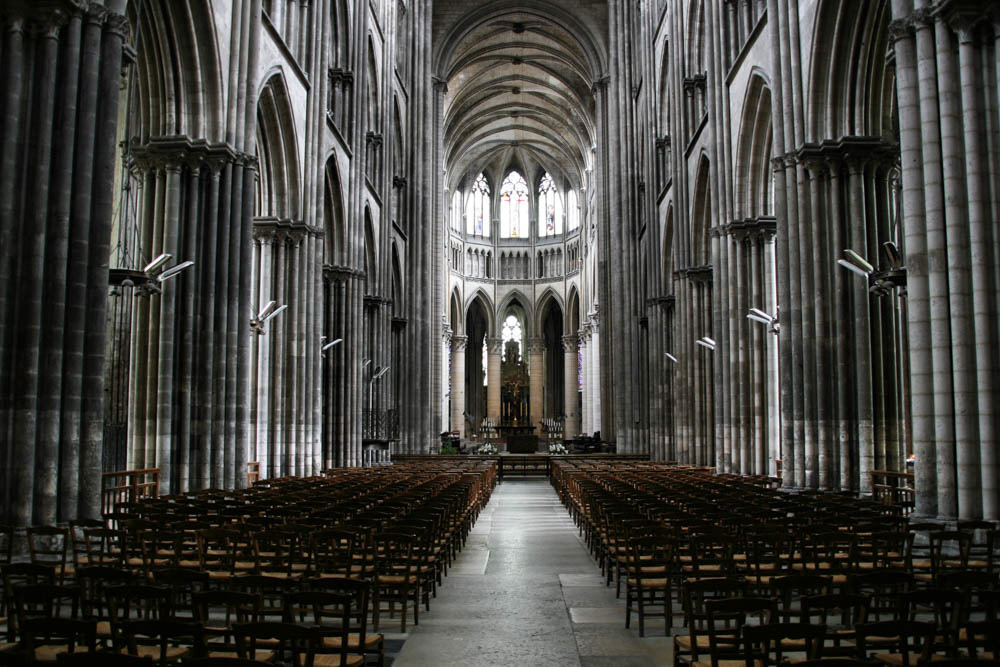
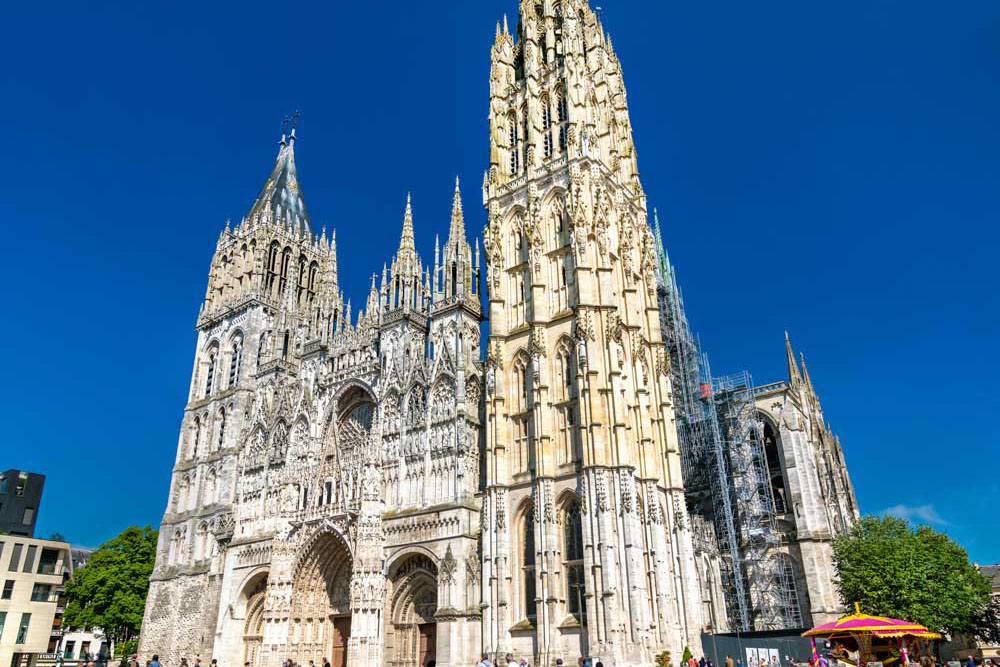
Rouen Cathedral’s history goes back a long way, and there are layers of heritage to uncover here. Christianity first arrived in the region as early as the 3rd century AD, and successive cathedrals were built in Rouen that became more and more elaborate, with each bishop and king wanting to add their touch.
William of Normandy (the same William who went on to later conquer England) had the cathedral consecrated in 1063 after major revamps, but additions, repairs, and redesigns continued over a thousand years later – even into the 20th century!
5. Visit the house and gardens of Claude Monet
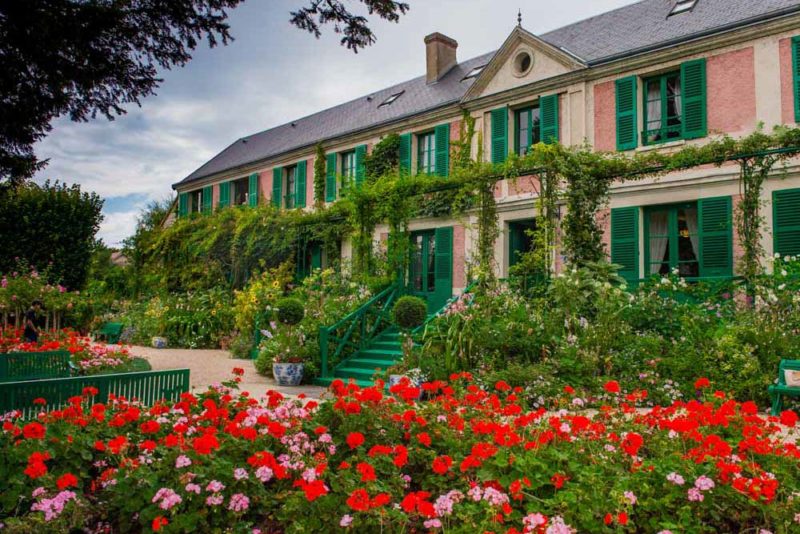
As you explore Normandy, you’ll soon come to understand how the region has produced such an impressive artistic legacy. After all, this is the home of the fabled Impressionists, who were inspired by the rural idylls and beautiful landscapes that you’ll see for yourself.
If you’re looking for your own inspiration, then we recommend visiting the house and gardens of Claude Monet, who is perhaps the most famous of the Impressionist painters. Monet’s landscapes and works are studied in classrooms across the world, and you can see where he painted many of his best at the Fondation Claude Monet in Giverny.
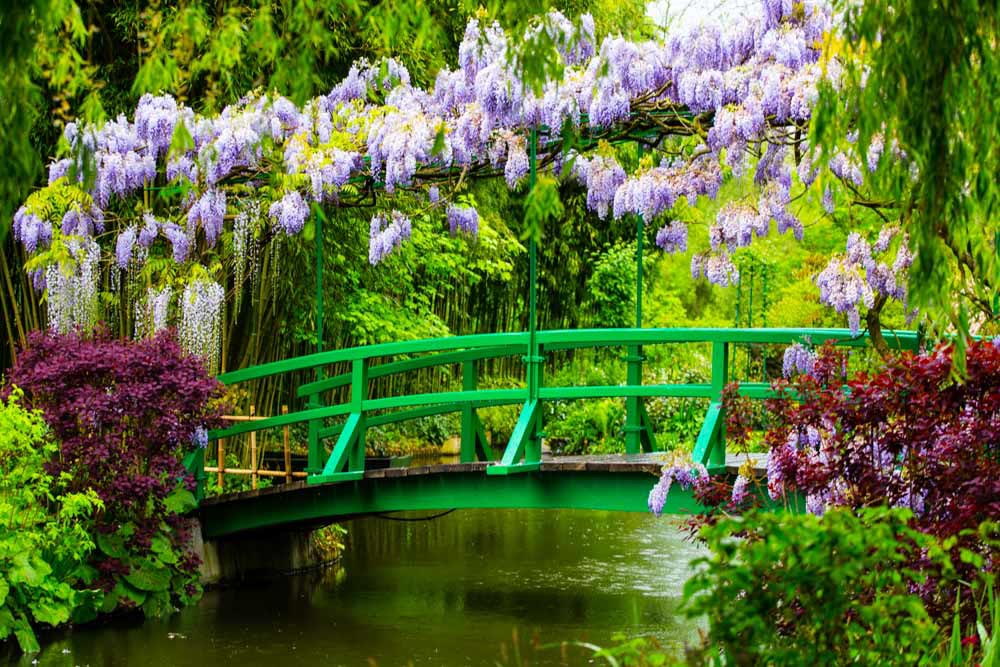
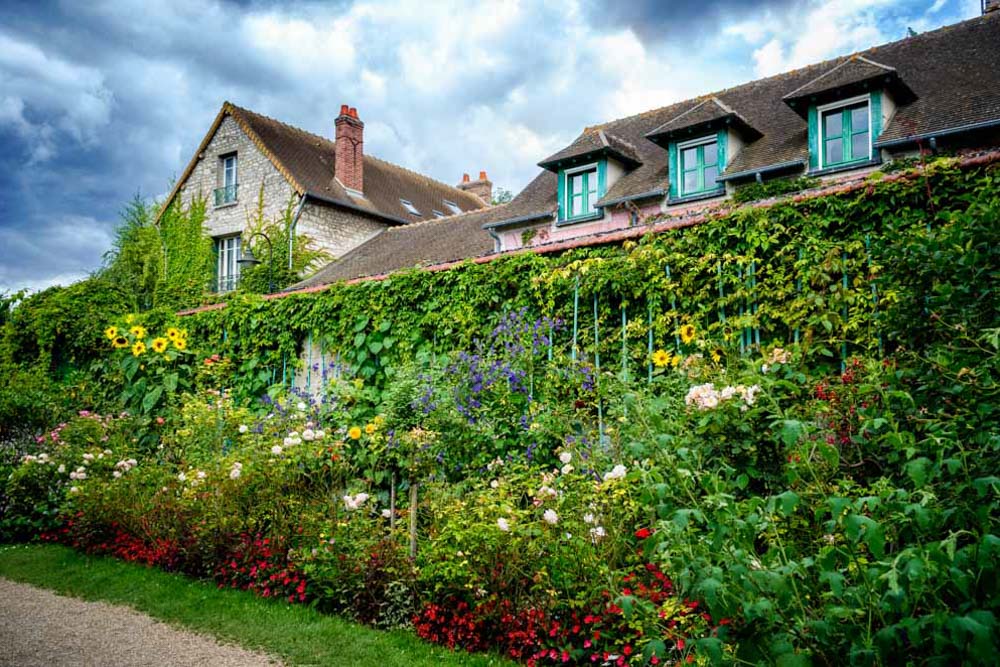
The Fondation Claude Monet protects Monet’s home and gardens, and it’s here where he lived and painted for some 40 years. You may recognize the gardens from his paintings, as he drew inspiration from the pond, the lilies, and the willow tree that is still found here today.
Monet’s presence in Giverny from 1883 onwards turned the small village in the Norman countryside into an artistic hub. The creative traditions continue today, and you’ll love the picturesque houses and streets that have provided so much inspiration for generations of painters.
6. Enjoy a beach day at Deauville
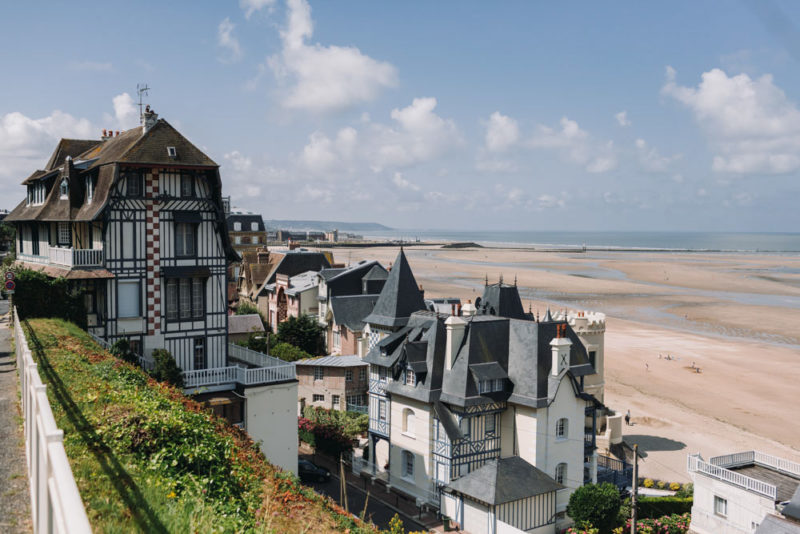
One of the best sights in Normandy is its long and spectacular coastline, so we highly recommend enjoying a beach day when you need a break from visiting museums and castles.
You’ll be spoiled for choice, so if you’re having trouble choosing, then it might be helpful to know that one of our favorite coastal destinations in Normandy is Deauville. This small coastal town is located in Calvados, and the area is perhaps better known in France as the Parisian Riviera.
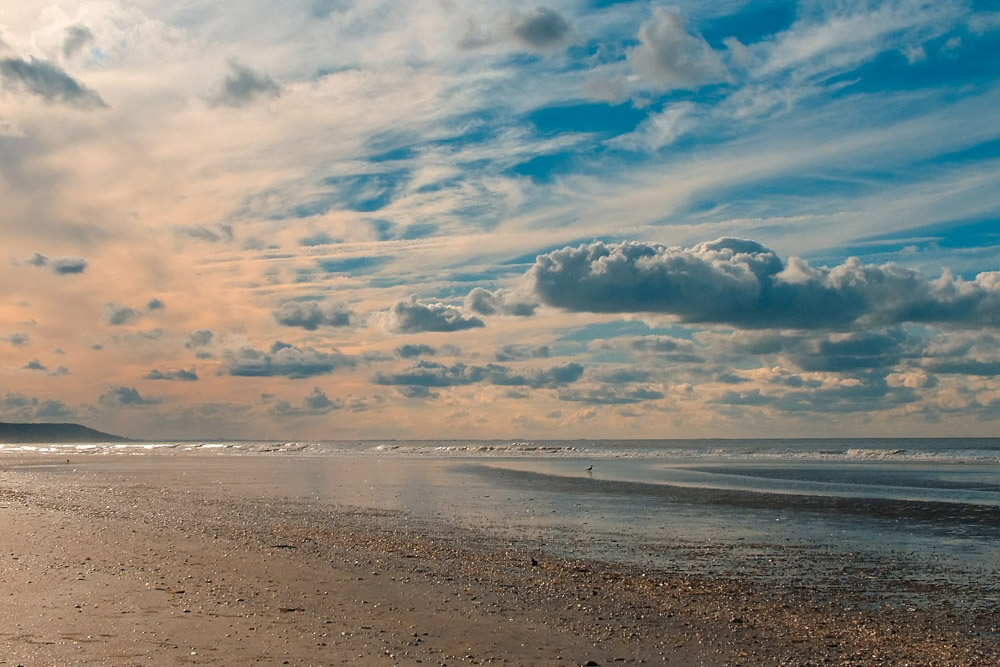
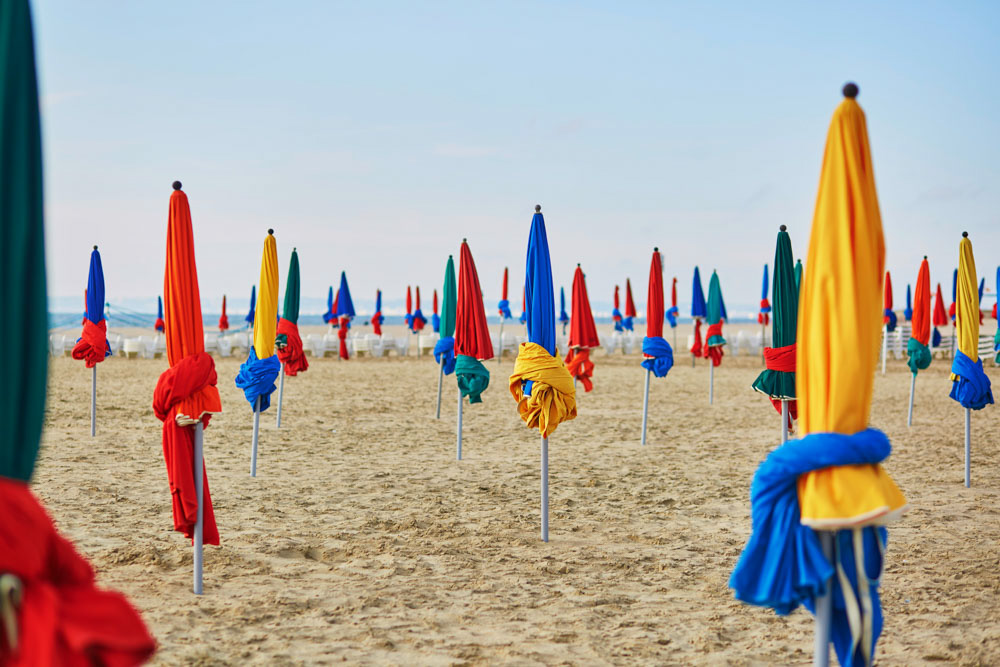
This is one of France’s pre-eminent coastal resorts, and since the 1800s, the seafront has attracted wealthy Parisians looking to escape the capital. Deauville is the closest resort town to Paris, and in the summer, it gets predictably busy. There are casinos, high-end resorts, and beachfront hotels catering to the rich and famous, as well as film festivals and cultural events that draw in the crowds.
But don’t let its popularity put you off, because Deauville is busy for a reason. The long, sandy beach is considered one of the best in Normandy (if not one of the best sandy beaches in France), and there’s plenty of space for everyone to enjoy the sand and sea here!
7. Admire the white cliffs of the Alabaster Coast
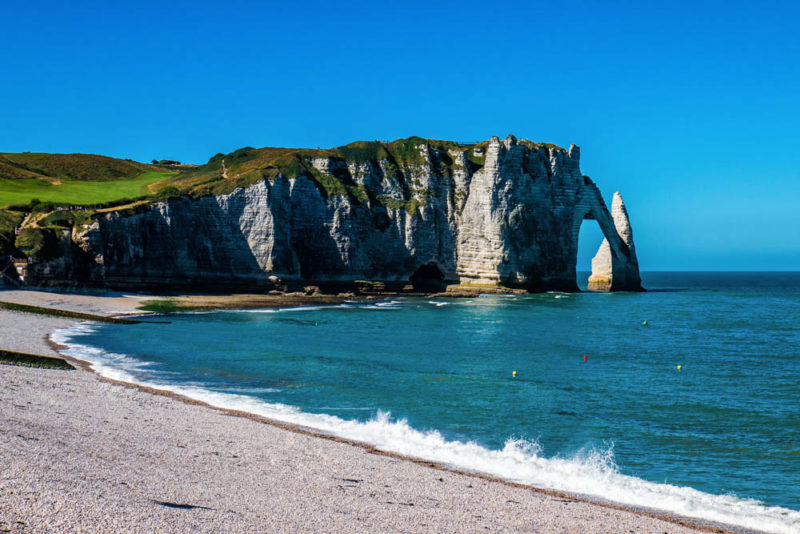
The most well-known white cliffs in the world might sit across the English Channel in Dover, but did you know that Normandy has its own dramatic white cliffs to rival those in England?
The Alabaster Coast stretches from Le Treport to Le Havre, and it covers a long stretch of coastline overlooking the English Channel. The coast is famed for its white, chalky cliffs, which mimic those on the other side of the Channel.
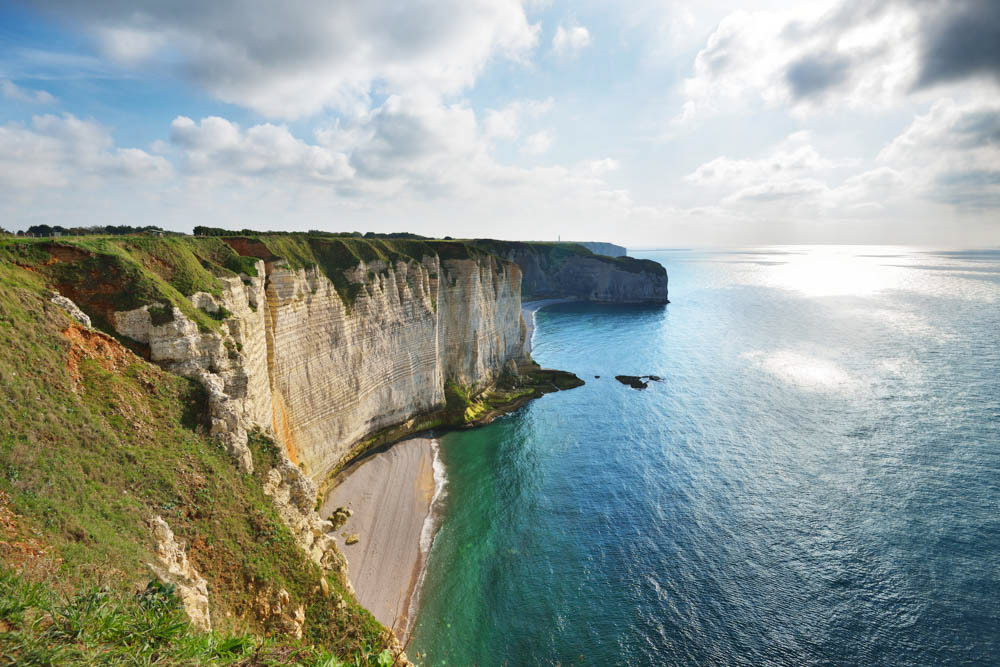
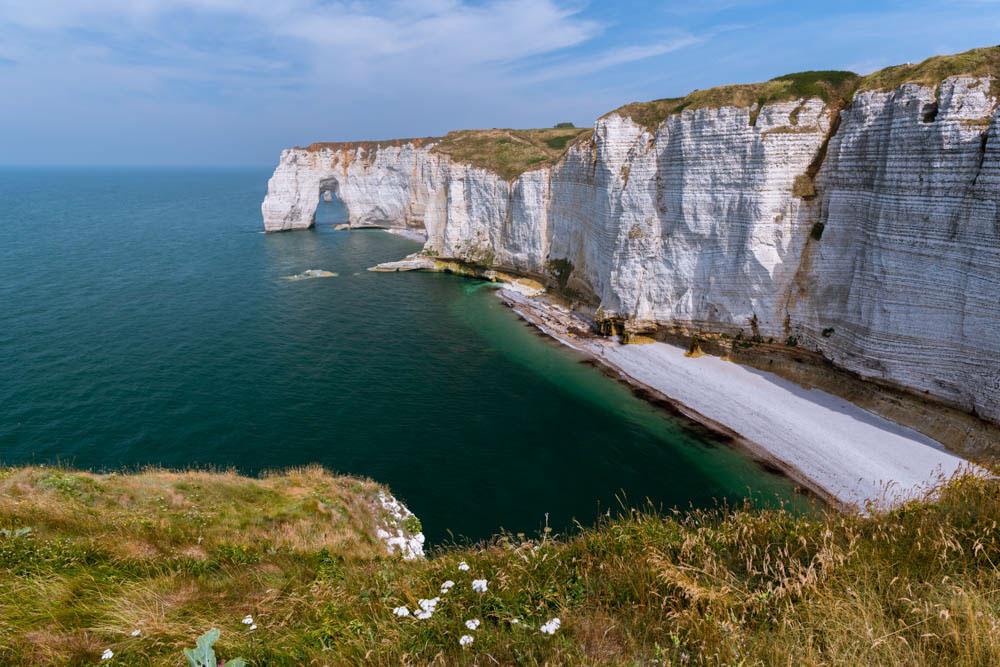
The dramatic landscape has been shaped by millennia of coastal erosion, and you’ll love the arches and high cliffs that are found here. One of the most impressive sights to visit is the Etretat Cliffs, which are located just to the northeast of Le Havre. At Etretat, you’ll find tall sea cliffs and magnificent natural archways that have been hollowed out by the waves of the English Channel.
8. See the scars of war at Omaha Beach
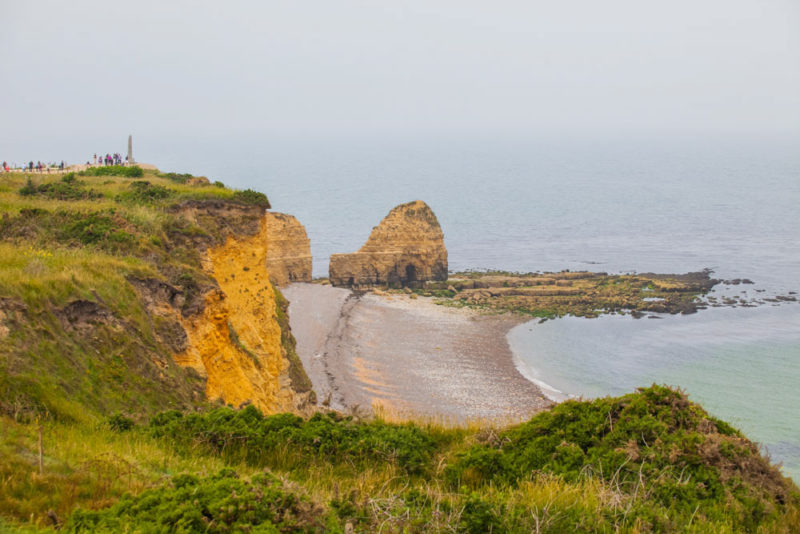
Normandy played a pivotal role in World War II when the coastline was selected by the Allied forces as the landing area for the invasion of Europe in 1944.
There were five different landing sites in total, with the Allies launching attacks on D-Day at Omaha, Utah, Juno, Sword, and Gold beaches. The following campaign in Normandy was bloody and brutal, and the area has since become an important destination for those with a keen interest in military history.

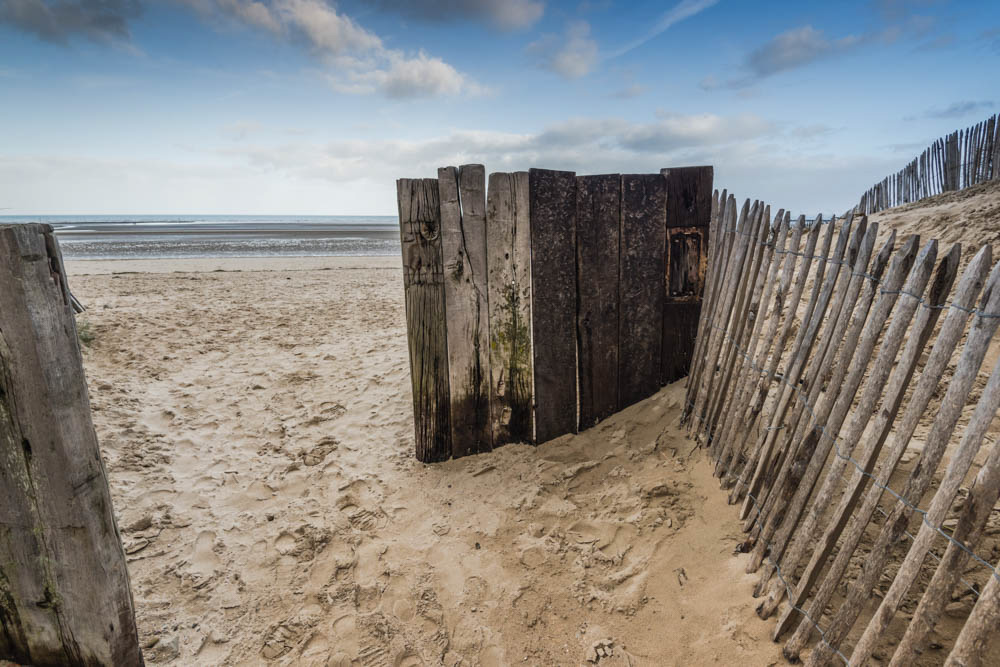
One of the most poignant military history destinations in Normandy is Omaha Beach, which became the scene of an infamous battle between American forces and German defenders. The battle was, of course, recreated in the movie Saving Private Ryan, which tried to remain faithful to the actual events of the day.
Much of the battlefield remains, and a visit to the beach – even many decades later – is a moving experience. You’ll be surprised at just how beautiful the beach is, where a long stretch of sand meets the English Channel. But you’ll also find the juxtaposition is stark when you visit the ruins of bunkers and gun emplacements that were fought over on D-Day.
9. Uncover 20th-century history at the Memorial de Caen
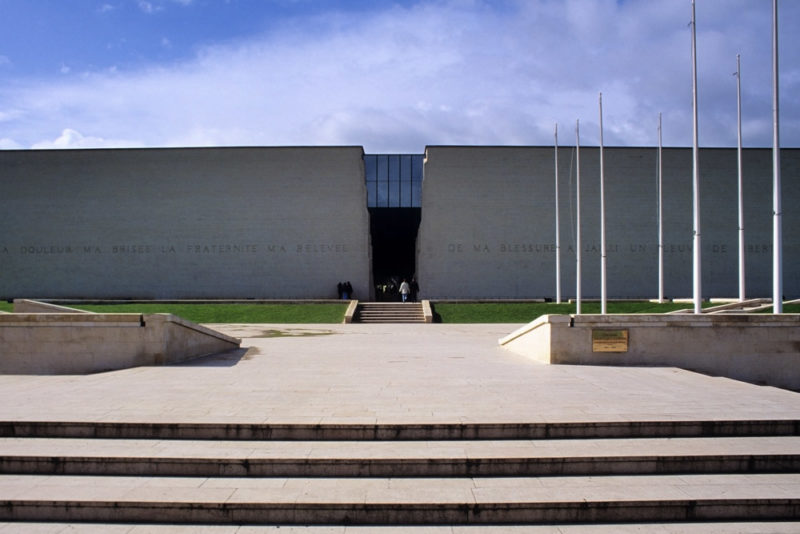
Caen is one of Normandy’s most important cities. Given its strategic location just a few miles inland from the D-Day landing sites, it’s no surprise that the city was fiercely fought over in 1944 as the Allies attempted to break out of Normandy and retake France.
The Memorial de Caen is a moving tribute to those soldiers and civilians who lost their lives in the conflict. But this isn’t just a memorial, it’s also a comprehensive museum, and it’s a must-see attraction if you’re interested in World War II history.
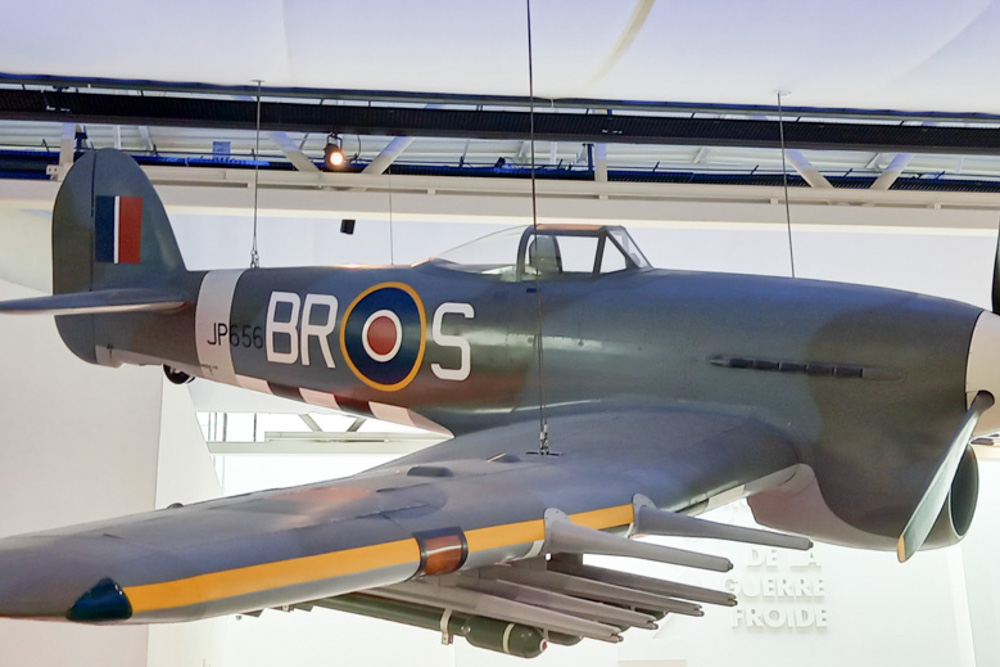
The museum is housed within a large purpose-built structure surrounded by green grass in the peaceful suburbs of Caen. The museum tells the story of the Normandy landings and Caen’s role in the battle, offering detailed blow-by-blow accounts of the campaign that raged here.
But the museum also delves back much further than the events of June 1944. In an effort to prevent conflicts from arising again, the museum depicts the events leading up to World War II, exploring the many causes and reasons why conflict erupted across Europe. The story then moves on to tell the visitors of the dark years of German occupation before the Normandy landings liberated the country.
The story doesn’t end there, though, and you’ll also learn how Europe was plunged into a Cold War even as World War II ended.
10. Marvel at Rouen’s fine art collection in the Musee des Beaux-Arts
If you’re a lover of fine arts, there’s no better place to visit in Normandy than the Musee des Beaux-Arts. This beautiful institution is located in Rouen, where for over two centuries, art connoisseurs have been visiting one of the finest collections in Europe.
The Musee des Beaux-Arts was founded in 1801 by none other than Napoleon Bonaparte. After his invasions of Europe, he needed somewhere to store all of the art his armies had brought back to France.
The museum moved to a new location in the 1870s and since then has grown its collection to hold thousands of works from across the continent. The collection is primarily dedicated to European fine art, of course, beginning in the 16th century and leading us to the present day.
You’ll find many famous works by famous artists in the corridors of the Musee des Beaux-Arts. There are paintings, sculptures, drawings, and artwork from the likes of Rubens, Velazquez, and Caravaggio. This being Normandy, there’s also an impressive body of work from the Impressionists, including several of Monet’s most popular works.
11. Be amazed by the Romanesque architecture of the Abbaye-aux-Hommes
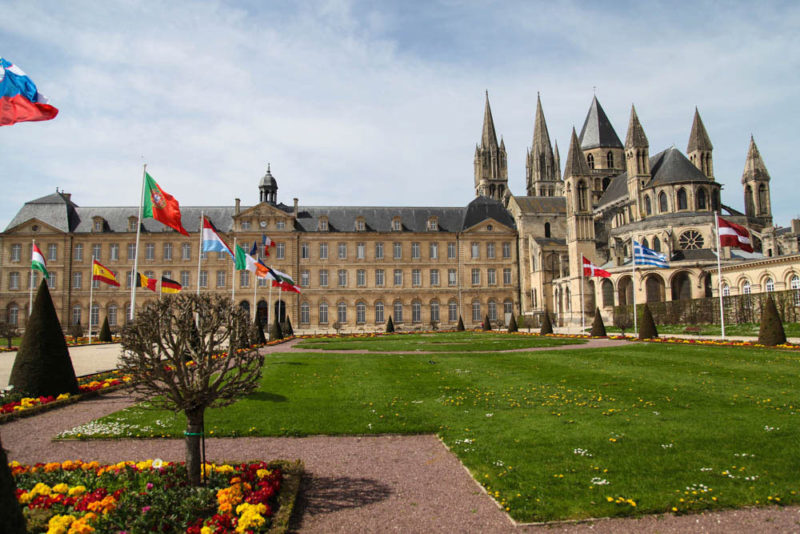
In the historic city of Caen, you’ll find one of the best sights in Normandy. Caen is home to the stunning Abbaye-aux-Hommes, an 11th-century abbey that’s well-regarded for its spectacular Romanesque-style architecture!
Abbaye-aux-Hommes means “Abbey of the Men,” although this is more of a moniker given the official name is Abbey of Saint-Etienne. The informal name distinguishes the abbey from the Abbaye-aux-Dames, or the “Abbey of the Women,” another religious institution also found in Caen.
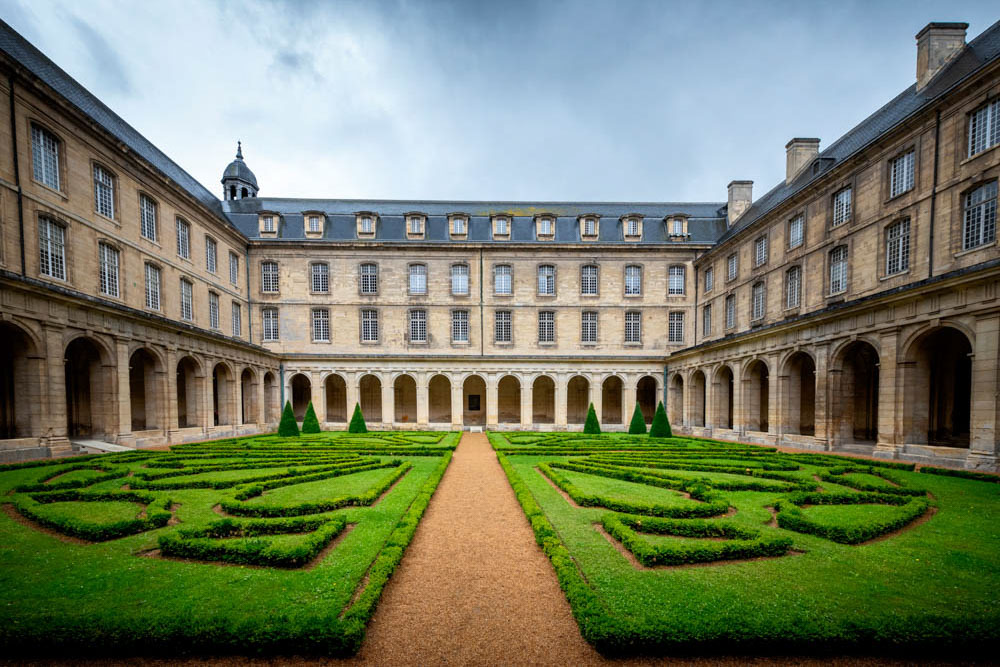
Abbaye-aux-Hommes is a Benedictine monastery, and it was founded by Normandy’s most infamous Duke, William the Conqueror. Construction began in 1066, the same year that William conquered England, although it wasn’t completed and consecrated until 1077.
Abbaye-aux-Hommes was built in a grand Romanesque style as William the Conqueror attempted to demonstrate his wealth and power to the Pope. Today, it’s still one of the most impressive buildings in Caen, and you’ll love walking through the high vaulted interiors and admiring the resplendent religious artifacts inside.
History buffs will love visiting Abbaye-aux-Hommes for another William the Conqueror-related reason, too. This is where William the Conqueror was laid to rest, and you can see his tomb inside the abbey to this day.
12. Explore Honfleur’s artistic legacy
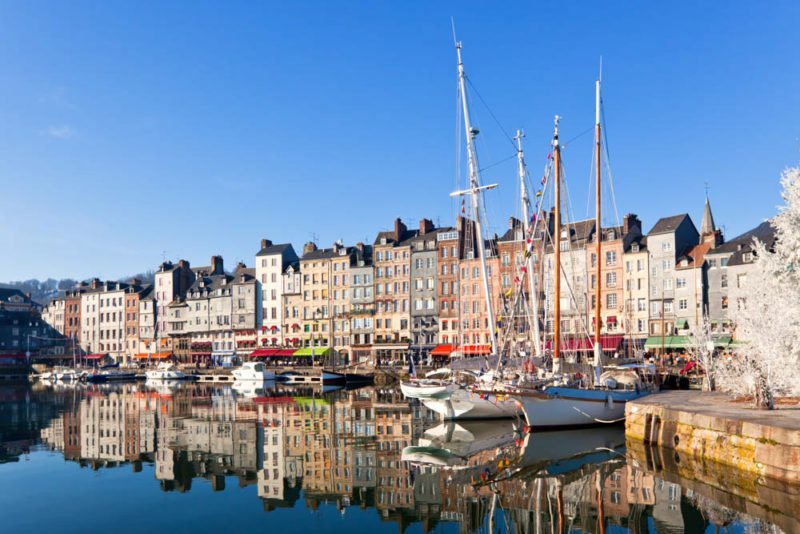
Honfleur is one of our favorite Normandy destinations, and we know you’re going to love the charming harbor, the views of the River Seine, and the colorful townhouses that this popular tourist town is known for.
Honfleur is located in a prime position on the Seine Estuary, and the town’s old port has provided shelter from the waves and currents of the English Channel for centuries. You’ll love walking along the harborfront, where slate-fronted buildings dating back to the medieval era rise high above the fishing boats in the marina.
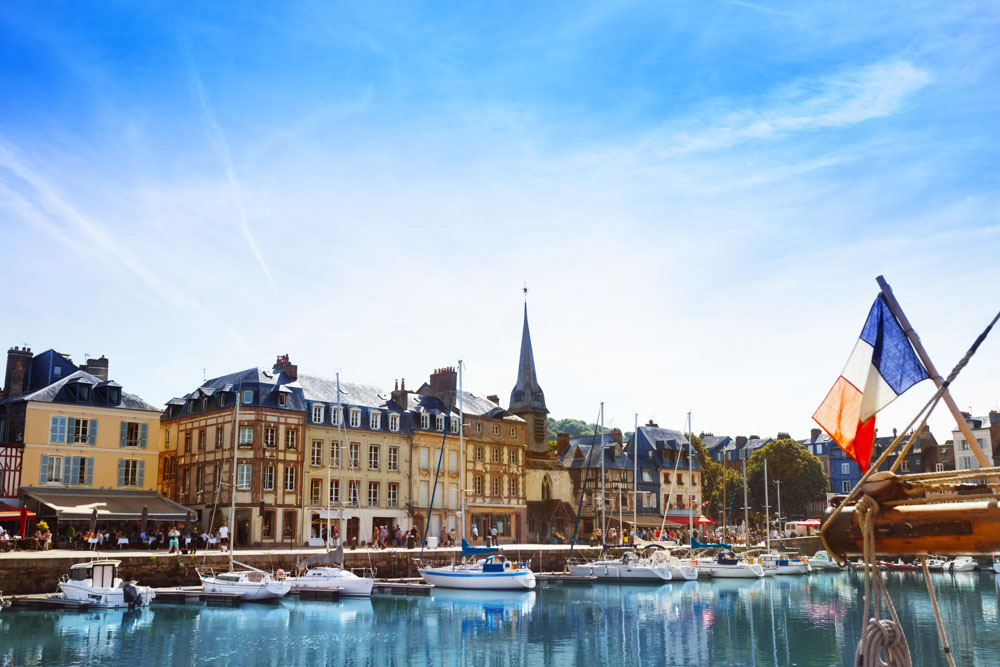
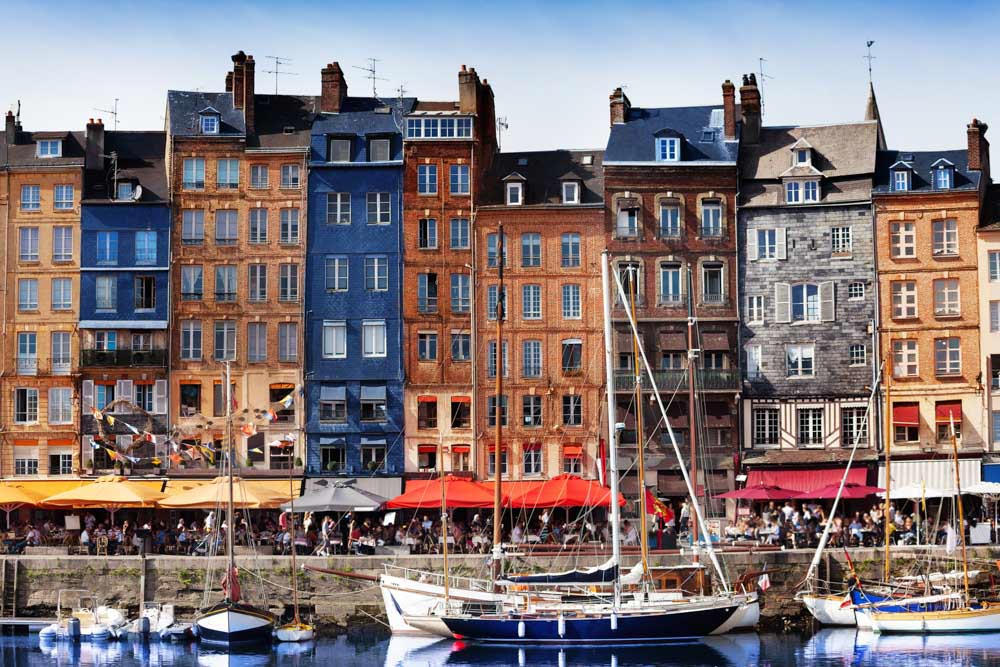
It’s a quaint place to visit, and as you walk around the cobblestone streets, you may begin to recognize many of the scenes from the often famous works of the Impressionists. Honfleur was a favorite spot for painters, including Eugène Boudin, who became better known as Claude Monet’s inspiration and mentor.
You might even find your own source of inspiration in Honfleur, be it from the sea breeze that drifts along the estuary or the wonderful history and heritage preserved in the buildings and architecture. Honfleur is also home to some of Normandy’s best restaurants, where there’s a particular emphasis, of course, on fresh seafood!
13. Take an amphibious craft to Tatihou Island
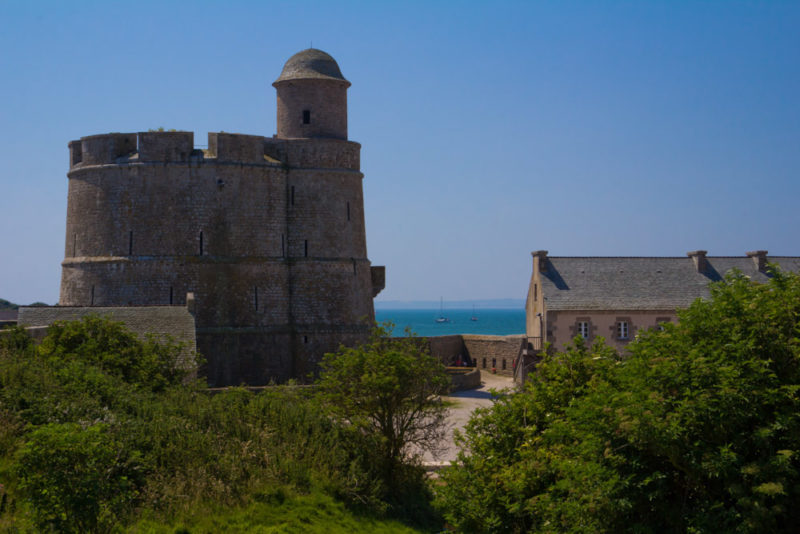
If you’re looking for fun things to do in Normandy, then why not take an amphibious craft to Tatihou Island? This small outcrop of land is located opposite the seaside town of Saint-Vaast-la-Hogue, and you’re going to love the sense of splendid isolation you’ll feel when you arrive.
Tatihou Island is small and it’s tidal. There are just 29 hectares of land here, and some of that gets submerged when the tides are high. You can join an amphibious tour from the mainland to reach the island, where you’ll find beautiful vistas, excellent scenery, and a few old military fortifications built to defend Normandy against English ships.
There’s no permanent population on the island because the area is a dedicated nature preserve. The island is a regular stopping-off point for migratory birds, so it’s a popular place for birdwatchers. Visitor numbers are limited in order to protect nature, but that just adds to that feeling of solitude that’s so difficult to find these days!
14. Cycle La Veloscenie from Normandy to Paris
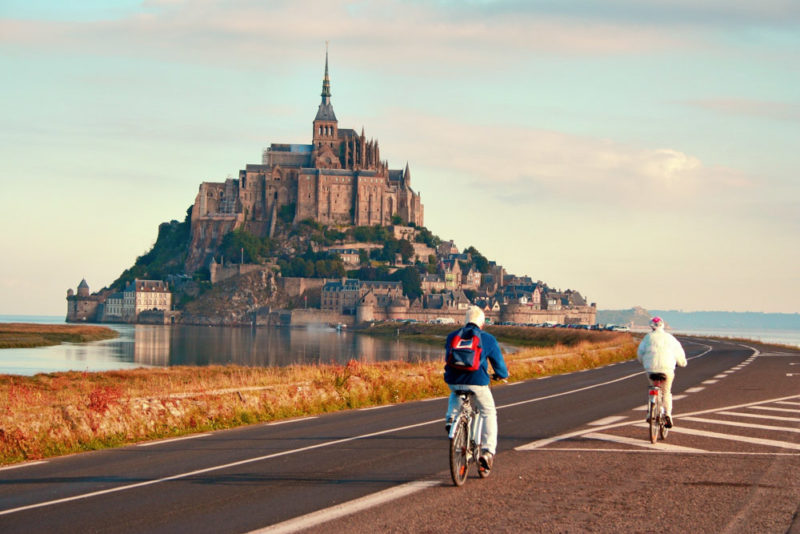
France is the true home of cycling, and if you love traveling on two wheels, then you’ll find that Normandy is a wonderfully accommodating destination for cyclists.
There are countless routes you can tackle, from coastal roads along the English Channel to rural lanes leading deep into the countryside. One route, though, stands out above them all, and that’s the almost 300-mile-long route of La Veloscenie.
Loosely translated as the “scenic bicycle route,” this epic long-distance journey starts by Mont-Saint-Michel, one of Normandy’s most iconic tourist attractions. From here, you cycle east through the Norman countryside and onto the city of Chartres in central France.
The route then leads through the suburbs of Paris, and you can join many more cycle routes that branch off to other regions of France and Europe. Continue further if you’ve got the time and energy, or you can end your journey in style on the Champs-Élysées, just like they do in the Tour de France!
15. Enjoy a tipple of Norman Calvados
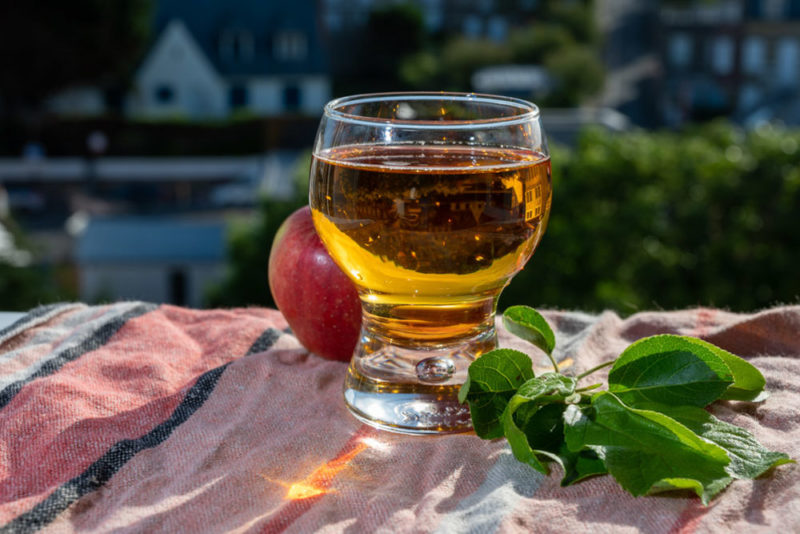
France is known for its wine production, a craft in which the country has excelled since time immemorial. But here in Normandy, they do things differently. While the rest of the country is busy growing grapes and fermenting wine, the Normans are more likely to be found growing apples and distilling Calvados.
Calvados is a brandy-like beverage that is distilled from apples. It’s named for the Calvados region in Normandy, where production has occurred since the days when Charlemagne ruled France in the 8th century AD.
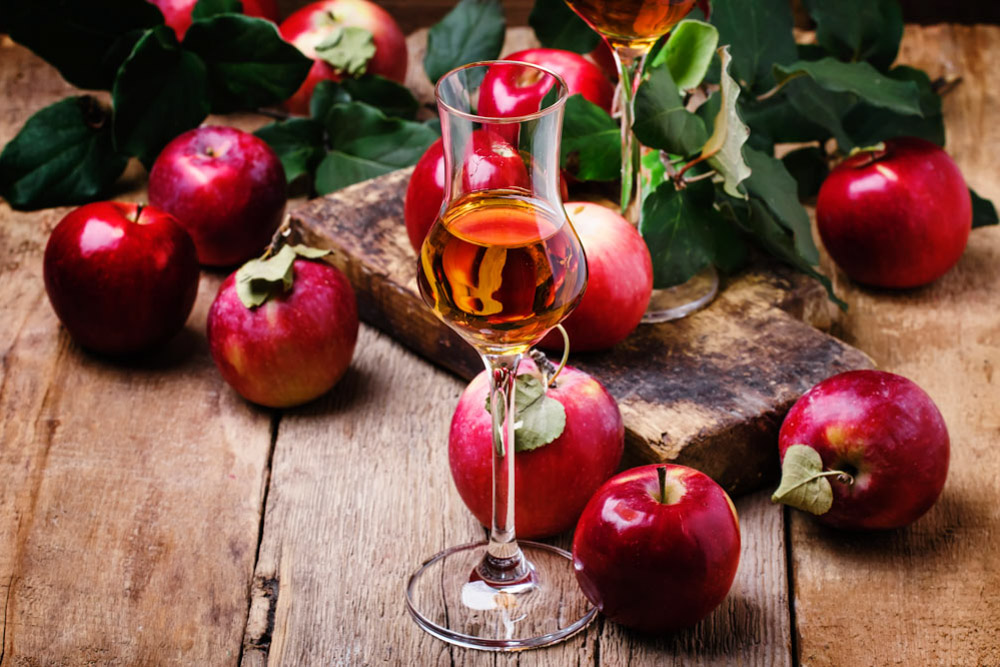
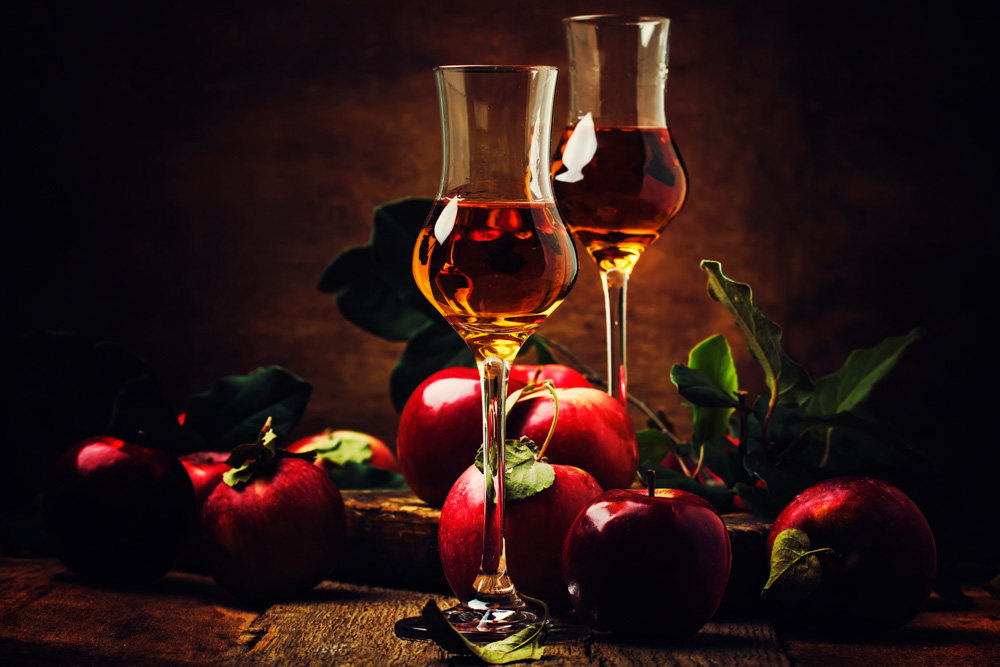
Visit the town of Pont L’Eveque, and you can learn more about the rich history of Calvados with a trip to the Calvados Experience. This tourist attraction offers a detailed insight into the origins of the drink, its popularity, and the production processes.
Due to the large quantities of apples grown in orchards across Normandy, the region is also well known for its cider. This is another tangent from the traditional winemaking activities of the French, and it connects the region more to the orchards and cider lovers over the Channel in England than it does to France’s wine-producing regions nearby!
There you have it! The 15 best things to do in Normandy. What’s your favorite thing to do in Normandy?
Planning a trip to Paris? Check out our favorite books and travel guides!
SHARE THIS ON PINTEREST
